Catch the replay of the 2021 Alibaba Cloud Summit Live at this link!
By Li Xiaoping , Chief Architect of Alibaba Cloud Middleware
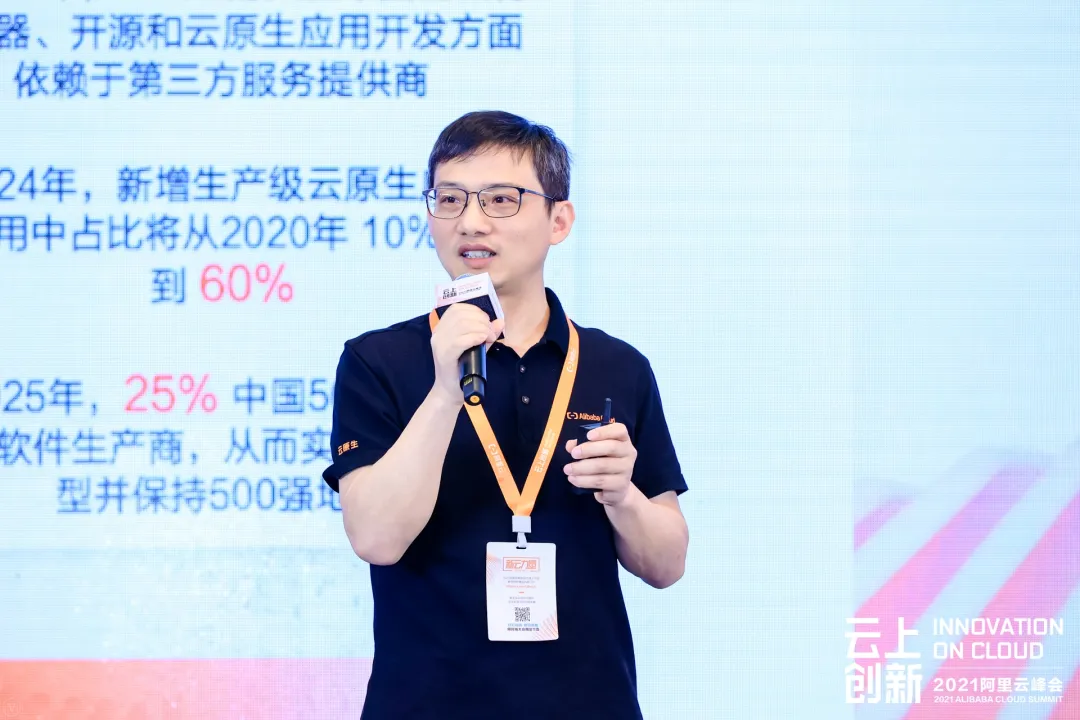
Recently, I attended the cloud-native industry conference held by the Institute of Information and Communications. Many enterprises from all walks of life attended the conference. I had so many thoughts and feelings during the conference. It reminded me of the moment I searched the word "cloud-native" on search engines in 2019. It was rarely searched back then. However, 2019 was a thriving year for the development of cloud-native in China. Today, a large number of enterprises have started applying cloud-native in technology, products, and ecology have attended the cloud-native conference. Therefore, cloud-native has evolved from a technology concept to an industry. Now, it has developed into a relatively large industry with the industry scale growing rapidly every year.
Today, there may be many consulting organizations, enterprises, or individual developers interpreting cloud-native, and many people may already have a deeper understanding of cloud-native. Everyone agrees cloud-native is related to the cloud, but what has been changed, and what value has it brought to the enterprises? The core idea should be to change the application architecture of an enterprise or reshape the cloud-native O&M system without changing the application architecture. The purpose behind this is to accelerate the value creation process of enterprises. In short, it is the same as manufacturing enterprises in improving production lines. The core idea is to improve the production lines for software enterprises.
Alibaba's practice in cloud-native began in 2006. Since then, we have accumulated a lot of experience in cloud-native development. We believe cloud-native provides many benefits to enterprises' digital innovation.
One benefit is resource elasticity. It is easy to understand that the word elasticity has different levels. For example, the elasticity based on virtual machines is provided in minutes. If the application based on these technologies is implemented in milliseconds, the problem of resource elasticity is only solved by minute-level elasticity, while the high availability problem of the overall applications needs to be resolved differently. If elasticity is applied in applications within milliseconds, the issue of high availability can also be solved.
The system stability also concerns us. Cloud-native picks out non-functional features throughout the software construction process and applies them to cloud-native products to set the application developers free from non-functional processing to focus more on functionality. Similarly, cloud-native has many tool concepts that can shorten the software development time from coding to launch. Likewise, today we have accumulated a lot of data on cloud-native observability. The data can be combined with machine learning capabilities to help us improve the user experience of enterprises, which brings great value to the business.
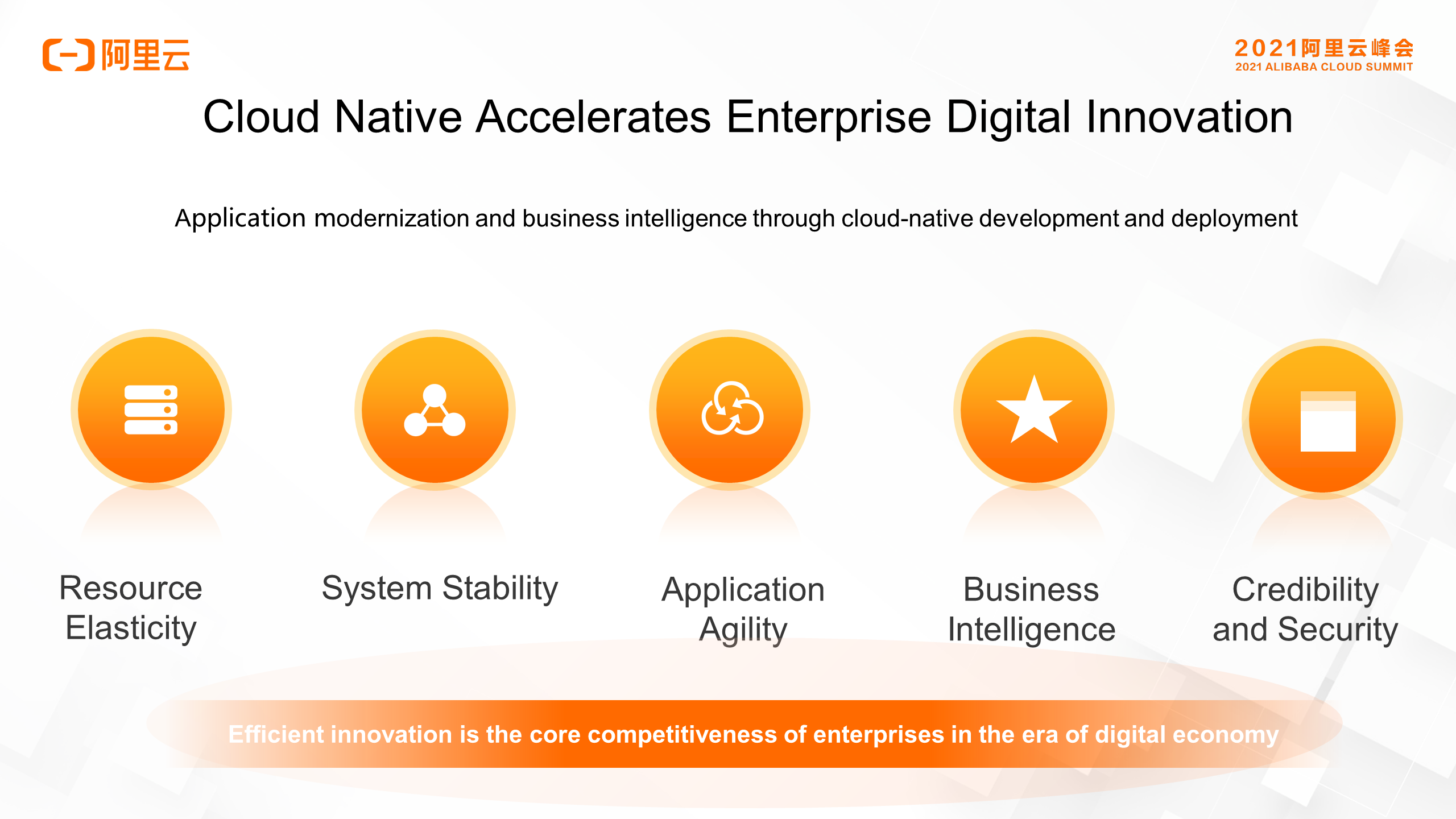
Cloud-native provides a variety of technology options for enterprises driven by CNCF, relevant domestic open sources, and third-party organizations. The question is, which one can be chosen to achieve the goal of production availability? When our business needs to go online in a short period and in a time of rapid business development, what kind of architecture and open-source products should be selected? This a problem technical decision-makers and architects of many enterprises face regularly.
In the cloud-native field, Alibaba Cloud started exclusive development earlier. From 2006 to 2009, when the development of Internet middleware began, and during the official establishment of Alibaba Cloud, we solved many business problems through cloud-native. Alibaba Cloud realized the rapid development of Taobao in its early days and the construction of Alibaba's middle platform in 2015 by applying cloud-native technologies. Now, the production system and core systems are all migrated to the cloud. The cloud-native technologies used in this process, such as container technology and microservice technology, support more than one million businesses.
Such scale of cloud-native implementation may not be achievable by most enterprises, especially for those that have a similar scale with Alibaba. However, by solving the performance and stability problems at such a large scale, Alibaba has accumulated a wealth of industry-leading technologies. Finally, Alibaba has applied these technologies to products publicly available to customers from all walks of life through Alibaba Cloud.
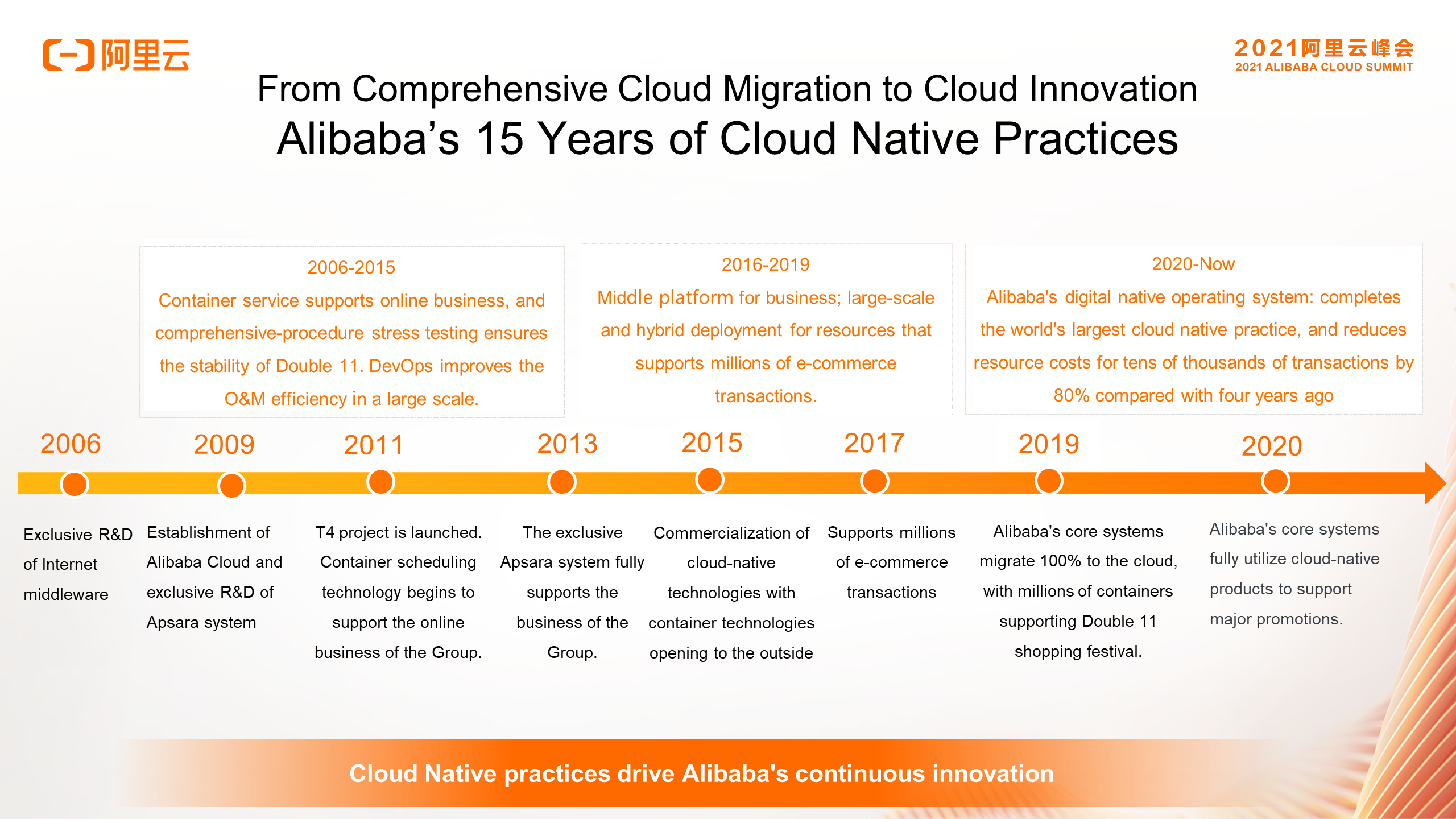
We believe cloud-native has profoundly changed the entire development process of software companies. First, Kubernetes has become a standard interface for software delivery. It changes the O&M and the entire production procedure from CI/CD to subsequent release and launch. Production processes have changed, and many enterprises have reshaped software architectures using cloud-native technologies. Therefore, the software architecture has changed from the traditional architecture to a new, so-called modern application architecture. Cloud-native can transform enterprises' production relationships and accelerate the software development for enterprises with the improvement of this production tool.
In practice, Alibaba Cloud has accumulated strong technical competitiveness in the following aspects:
First, we have many leading technologies to solve the stability and reliability problems in the cloud-native field and the high concurrency problems on a large scale. At the same time, we will output all these technologies in an open-source form. We know that in the cloud-native world, enterprises need open-source and open technologies rather than technologies owned by a single vendor, such as Alibaba. In this process, we have accumulated industry-leading capabilities of many products based on open-source and open technology standards. The products include cloud-native databases and cloud-native big data as well as those based on cloud-native application architectures.
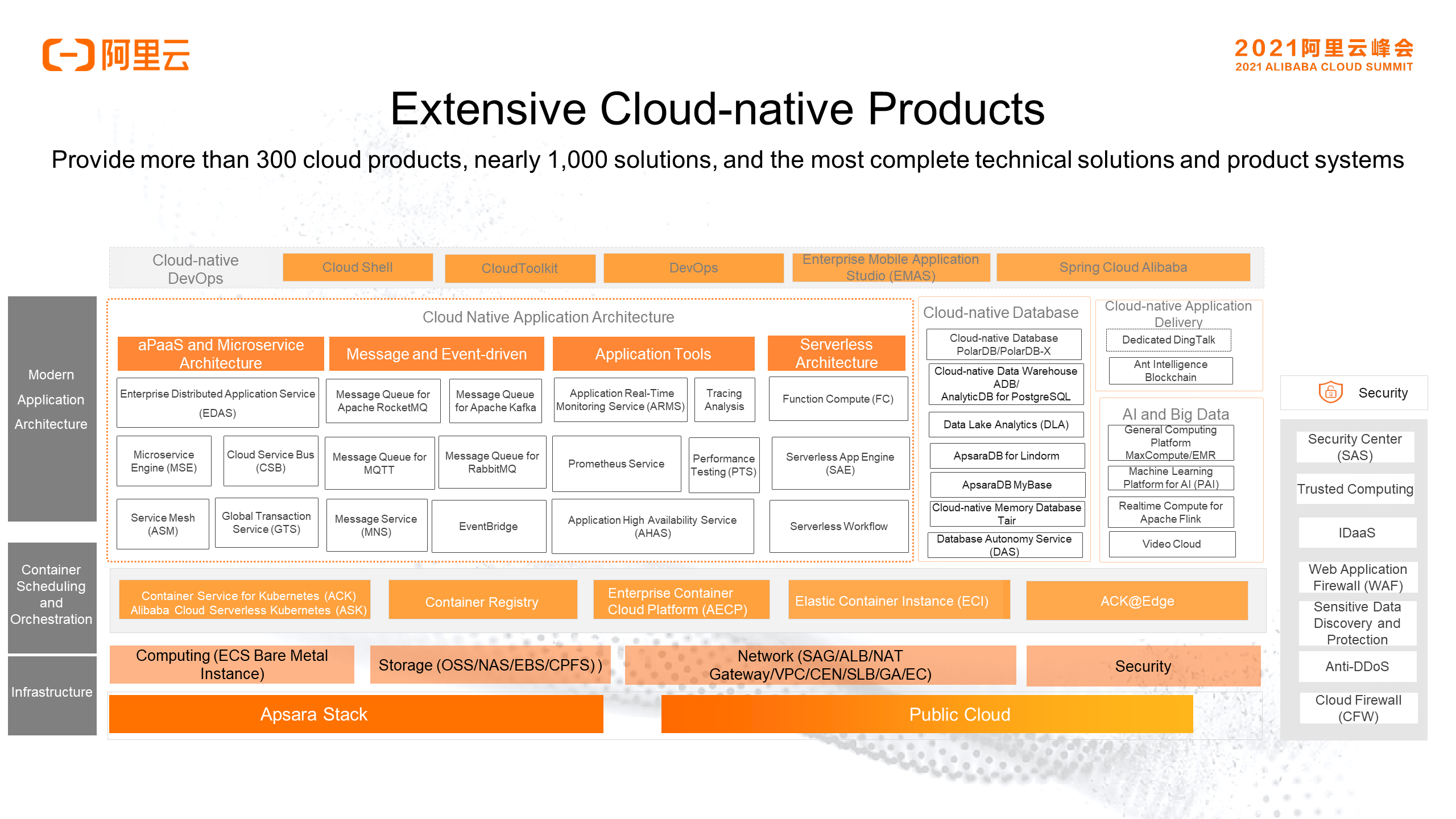
There are many evaluations in cloud-native fields. In these evaluations, Alibaba Cloud Container Service for Kubernetes (ACK) was awarded full marks by Gartner in its 2020 evaluation, making it one of the two vendors that received full marks among the global vendors. This year, Alibaba Cloud was included in the Gartner competitive landscape for containers again. Alibaba Cloud also entered the Forrester FaaS leader quadrant in the emerging fields of computing in 2021. Alibaba Cloud Function Compute won the highest score among all FaaS products in the world.
Alibaba Cloud Function Compute Enters the Forrester Leader Quadrant for the First Time >>
In terms of observability, Alibaba Cloud entered Gartner's APM quadrant on behalf of domestic cloud vendors. All these third-party assessments reflect the capabilities of Alibaba Cloud products. In terms of container architecture, in-depth optimizations have been done based on the open-source Kubernetes technical system and the Alibaba Cloud hardware to provide services for many Kubernetes applications in many fields and scenarios. We have added the management capability of ultra-large clusters in Kubernetes clusters to ACK, so the complexity problem of large-scale cluster management can be solved for Alibaba Cloud customers.
For example, Perfect Diary, a unicorn company in the beauty industry, has enjoyed fast business development. However, in this process, the problems they face are reserving resources better, solving the problems of newly launched functions better, and the stability of requirements during shopping sprees. To solve these problems, it uses PTS for stress testing with all applications running on the ACK platform to simulate the traffic of big promotions. As such, the entire promotion process can be upgraded from requiring a large amount of investment to normalizing the stress testing of the promotion, which also alleviates the stability-related issues of the system.
In addition to microservices, messages, and various application tools, cloud-native middleware provides many solutions based on common enterprise IT scenarios. Alibaba Cloud middleware was developed in large-scale service calls within the Alibaba Group. It is compatible with open-source products and incorporates more product capabilities, such as high observability and availability during big promotions. These all belong to the system of cloud-native middleware products.
Similarly, in the middleware field, we have also had corresponding cooperation with more enterprise customers. Chanjet is an enterprise that develops SaaS products. It has run cloud management services for more than four million small and micro enterprises. The ToB type applications are very complicated. The biggest problem is that the release frequency of the whole software is very high. How can we solve various software bugs under the high-frequency software release or solve the problem of stability caused by the lack of design? They are the focus of Chanjet in the early stage of the discussion. The application of cloud-native middleware solves the problem of application observability but also equips the applications with 360-degree observability without dead angles. Through application detection, various possible instability risks can be detected quickly during the whole stress testing process, allowing the corresponding risks to be converged quickly.
Many academic institutions have made in-depth studies in the Serverless field. We believe that Serverless will probably become the next mainstream technology. Alibaba Cloud implements industry-leading millisecond-level billing in the Serverless field and profound optimization at the bottom layer of Alibaba Cloud. This enables intelligent flexibility, ultimate O&M, and significant improvement in development efficiency for customers' applications. Alibaba Cloud has also cooperated in-depth with many enterprise customers to implement Serverless implementation. It helps customers migrate applications to the Serverless technical system to achieve fast application deployment. Meanwhile, it entrusts the problem of application stability and O&M to cloud products, such as Serverless.
In the rapid development of cloud-native technology, only through continuous technological innovation and product innovation can cloud-native technology better serve the vast number of enterprise customers. Alibaba Cloud has released four major solutions, the comprehensive-procedure stress testing solution, the multi-datacenter solution, the hybrid deployment solution, and the observability solution. These solutions can efficiently solve problems that have not been solved in traditional fields. For example, as you may know, the comprehensive-procedure stress testing works very well. The big problem is to minimize application modification or stop modification completely. Therefore, the upgrade of Alibaba Cloud's comprehensive-procedure stress testing can help solve these problems in enterprise applications.
Today, as enterprises are continuously making in-depth use of the cloud, they often encounter the problem of low overall CPU utilization in both public clouds and Apsara Stack. Nevertheless, hybrid deployment allows a variety of offline and online tasks to be deployed together and benefit from resource scheduling, improving the CPU utilization of the entire data center. In this process, the stability and resource occupation problems after hybrid deployment must be solved. Alibaba adopted this large-scale hybrid deployment earlier, like the cloud-native products that supported the Double 11 Global Shopping Festival. Today, we are also trying to output hybrid deployment capabilities as solutions.
Alibaba implemented the unitized architecture earlier, where it achieved the multi-datacenter. Today, the unitized architecture is considered as a multi-datacenter solution that can support scenarios, such as private clouds, data centers, public clouds, and hybrid clouds, for the multi-datacenter of the entire applications.
Observability has always been a topic of special concern because it allows us to actively identify various risks that may occur during system operation. Today, Alibaba Cloud's upgraded observability solution includes a variety of frontend performance monitoring, from synthetic monitoring to backend applications and even cloud services.
In addition to solution innovations, we have made many upgrades to our cloud-native products. The backup and disaster recovery center of ACK has been released to protect the integrity of clusters, applications, and data:
The Container Registry has released the services to build enterprise-level Serverless, which improves the construction efficiency and user experience of cloud-native products substantially:
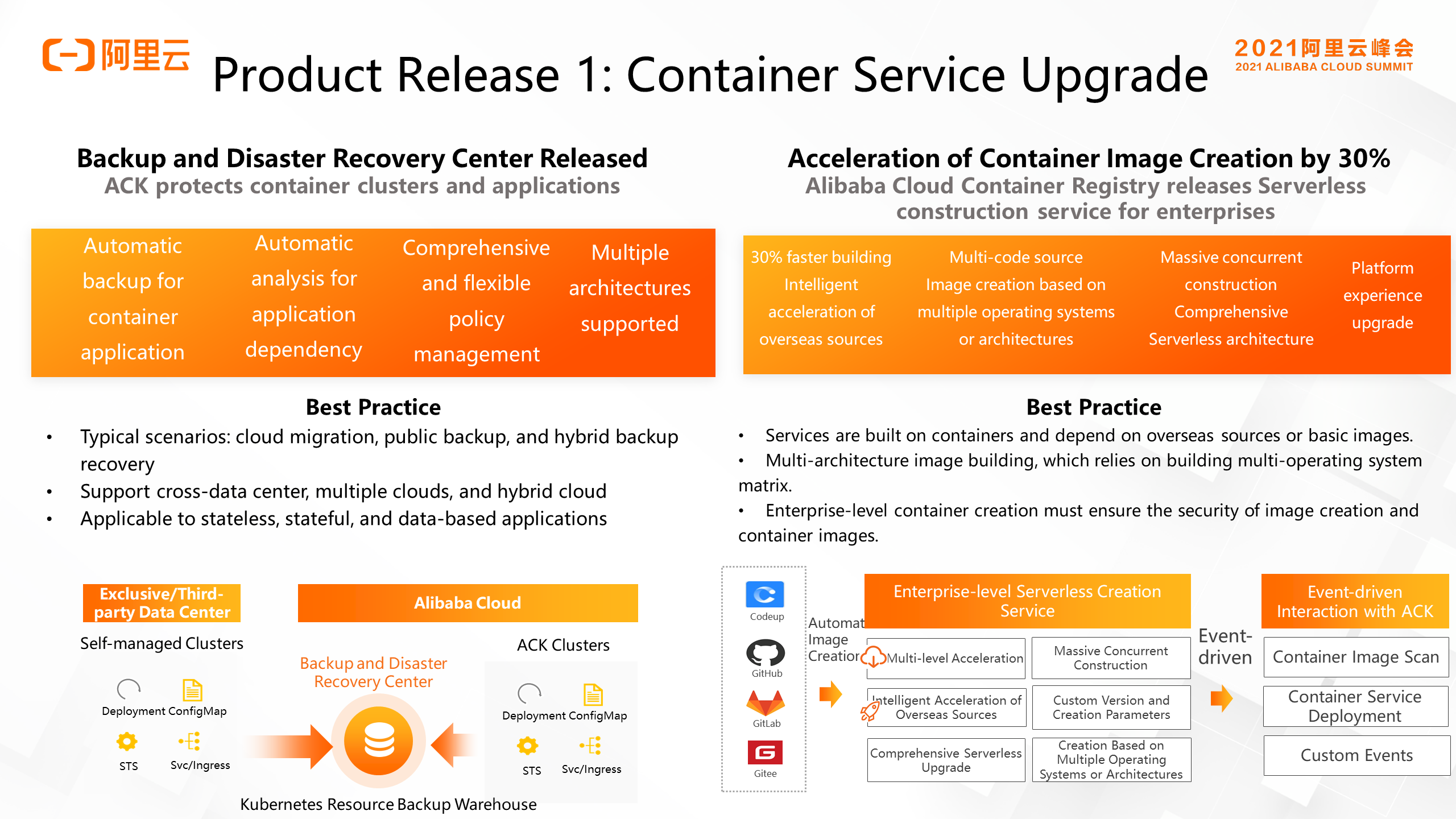
In the field of microservices, Alibaba Cloud Service Mesh (ASM) is an option for more applications. Customers want it to have stronger microservice governance capabilities on top of open-source technologies. Therefore, Alibaba Cloud launched a professional version called ASM Pro, with enhanced multi-protocol support, improved dynamic scaling capabilities, refined service governance, and an improved zero-trust security system. Compared with the standard version released in 2020, the professional version has improved its performance and scale significantly. It is also enhanced in the differentiation competitiveness compared with the open-source version, lowering the threshold for users to implement the service mesh in the production environment.
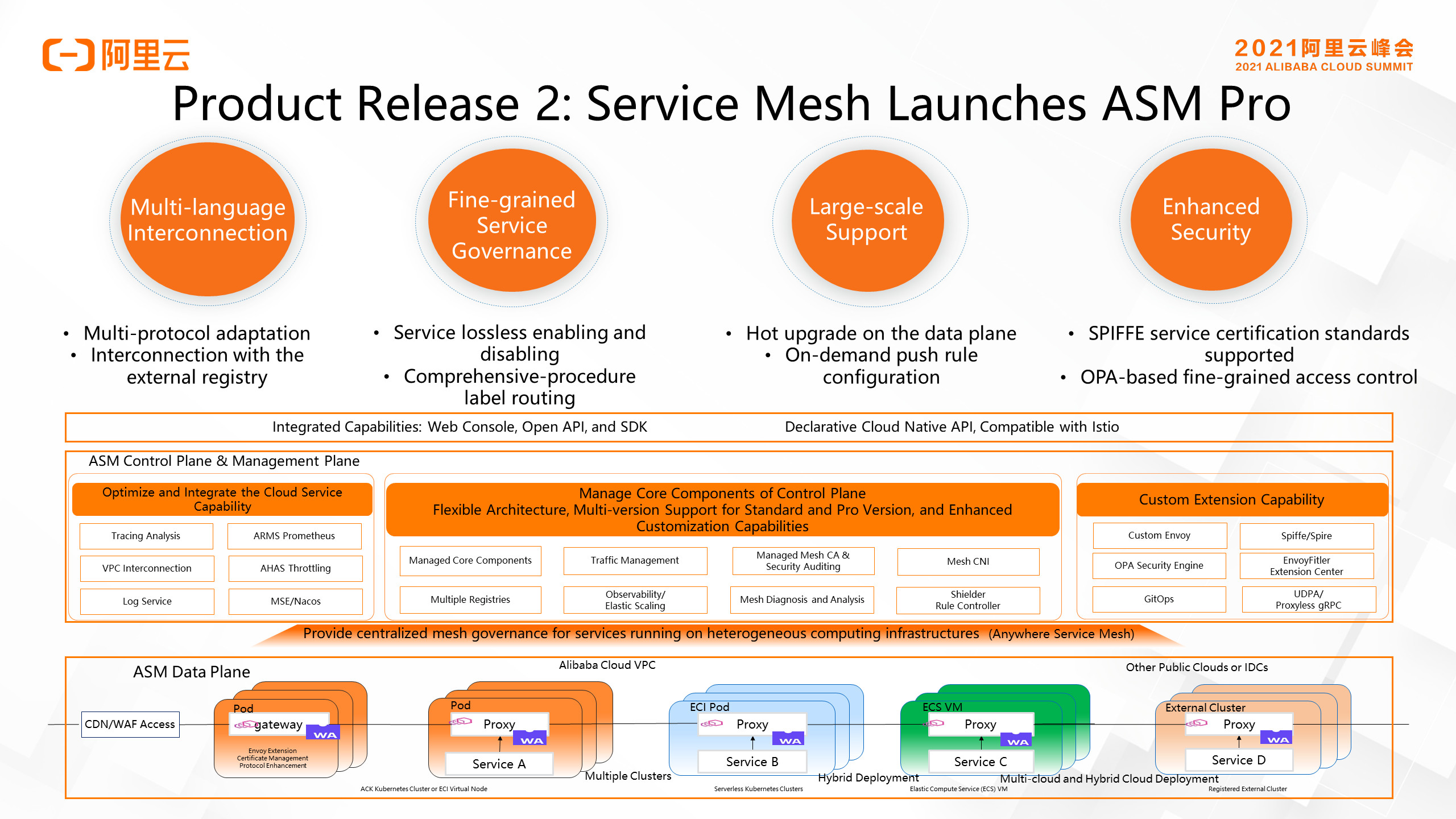
Gartner predicts that event-driven architecture will become the mainstream architecture in business development in the future. In the cloud migration process, enterprise customers have clear pain points and demands for low-code and serverless elastic application architecture and the lightweight integration of the data streams of various heterogeneous cloud services. Hence, Alibaba Cloud launched EventBridge, which aims to unify the event standards defined by Alibaba Cloud services, third-party SaaS providers, and users. It helps users to obtain and process a large number of events quickly at low costs through standard, flexible, and lightweight core capabilities to drive business development.
In the past, we have expanded and upgraded the product capabilities of EventBridge:
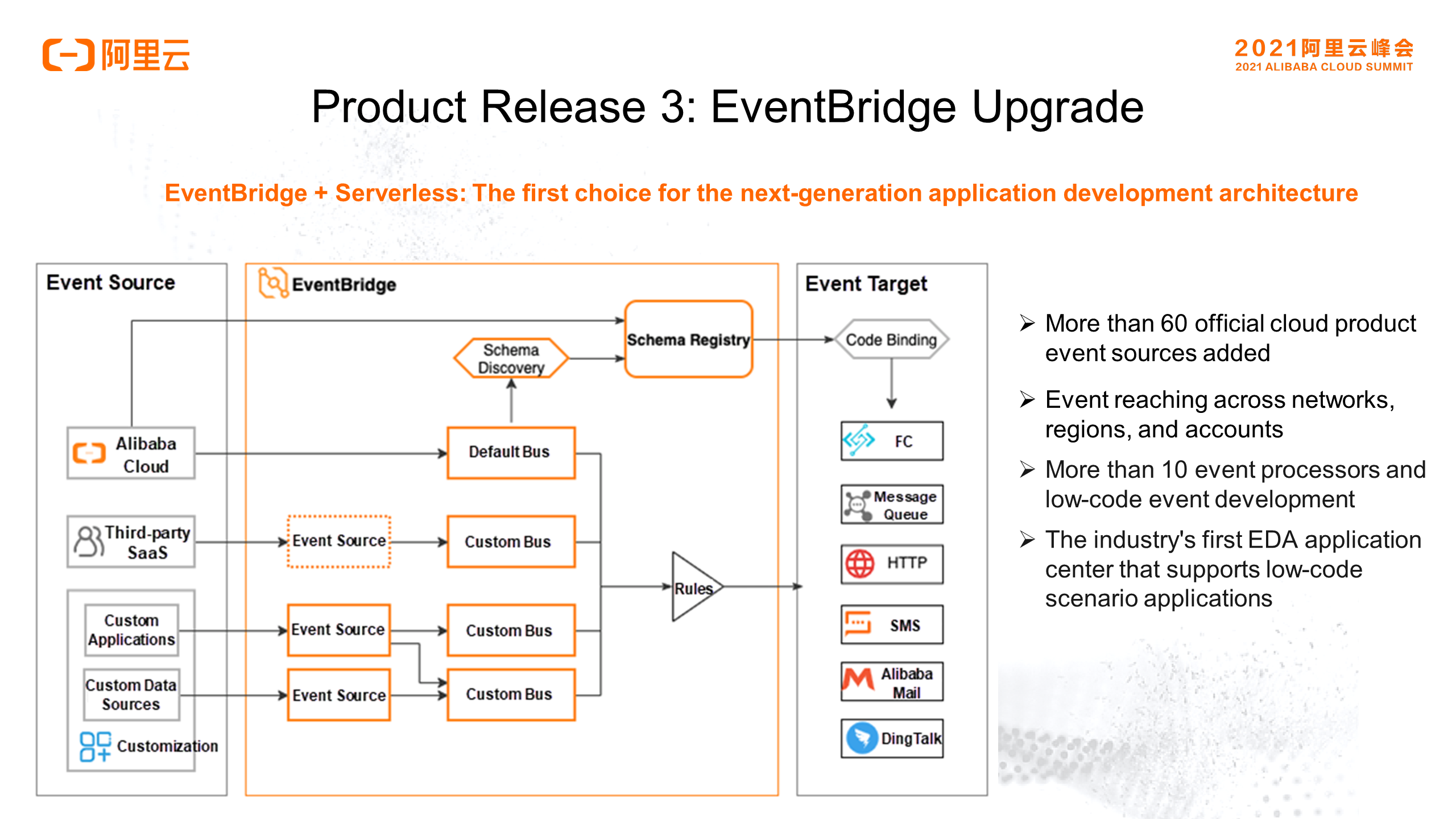
Alibaba Cloud has the widest range of cloud-native customers. As more enterprise customers migrate to the cloud, more complex scenarios will be in demand, and requirements for cloud-native technologies, products, and the cloud-native concept will be higher. Alibaba Cloud hopes to make more explorations in the cloud-native field with users from all walks of life. We also want to bring more business value to enterprises through cloud-native technology to boost the business innovation of enterprises.
Alibaba Cloud Sets the Standard for Open Application Architecture in Cloud Computing

208 posts | 12 followers
FollowAlibaba Cloud Native - October 27, 2021
Alibaba Cloud Native Community - April 7, 2022
CloudNative - May 10, 2022
Alibaba Clouder - June 8, 2020
Alibaba Cloud Native Community - December 16, 2021
Alibaba Clouder - February 2, 2021

208 posts | 12 followers
Follow Function Compute
Function Compute
Alibaba Cloud Function Compute is a fully-managed event-driven compute service. It allows you to focus on writing and uploading code without the need to manage infrastructure such as servers.
Learn More .COM Domain
.COM Domain
Limited Offer! Only $4.90/1st Year for New Users.
Learn More Serverless Workflow
Serverless Workflow
Visualization, O&M-free orchestration, and Coordination of Stateful Application Scenarios
Learn More Serverless Application Engine
Serverless Application Engine
Serverless Application Engine (SAE) is the world's first application-oriented serverless PaaS, providing a cost-effective and highly efficient one-stop application hosting solution.
Learn MoreMore Posts by Alibaba Cloud Native